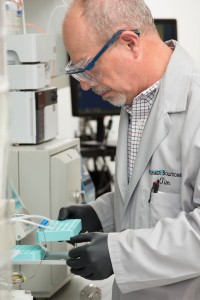Have you ever read th e flavor description on a wine bottle and wondered who the heck really tastes “hints of peach with a floral undertone” in that $6 chardonnay? Describing a wine is probably more art than science, relying on the taster’s ability to actually detect elements that are present in the mixture that makes up the wine, and his creativity in describing his impression of the vintage.
e flavor description on a wine bottle and wondered who the heck really tastes “hints of peach with a floral undertone” in that $6 chardonnay? Describing a wine is probably more art than science, relying on the taster’s ability to actually detect elements that are present in the mixture that makes up the wine, and his creativity in describing his impression of the vintage.
In chemical testing, we have a much better way to identify ingredients in a complex mixture: chromatography. And even though it’s pure science, we think chromatography is as cool as any wine taster’s job.
Although multiple types of chromatography are useful in separating and identifying complex mixtures, how it works is fairly simple. The sample we’re testing is separated into its various components based on their molecular properties. Molecules are carried through the chromatographic system by a mobile phase. The mobile phase may be a liquid or a gas depending upon the molecules we need to separate. Volatile molecules will be carried by a gaseous mobile phase, and non-volatile molecules by a liquid mobile phase. By moving the sample components over or through another substance, called the stationary phase, the components of the sample begin to separate based on the ease with which they pass through this substance. Once they’re separated, we can identify and quantify the individual species present.
In theory, you could conduct chromatographic testing on virtually any mixture, including cheap chardonnay. Polymer Solutions Incorporated’s chromatography group conducts multiple types of chromatography, including:
- Gas chromatography — As the name implies, this type of chromatography is used to analyze gases, and volatile and semi-volatile organic compounds.
- Gas chromatography-Mass Spectrometry — When we’re dealing with a complex mixture of unknowns, the sensitivity and specificity of GC-MS allows us to identify even the smallest traces of substances in the mixture.
- Headspace gas chromatography — To test solid or liquid samples using headspace gas chromatography, we seal the sample in a headspace vial, sometimes putting the sample in solution to facilitate the transition to a gaseous state. Heat drives the sample’s volatilization into a gaseous state.
- High-performance liquid chromatography (HPLC) — When we’re testing complex mixtures that contain polymer additives, active pharmaceutical ingredients or impurities, HPLC allows us to separate and quantify a cornucopia of non-volatile compounds.
- Liquid chromatography mass spectrometry (LC-MS) — Combining two powerful testing methods, LC-MS works well when we’re testing samples that contain unknown non-volatile compounds or impurities.
- Size exclusion chromatography (SEC) — Also called gel permeation chromatography (GPC), this method is capable of measuring the molecular weight distribution of a polymer sample, as well as quantifying the polymer within the sample.
Chromatography isn’t just incredibly useful, however. It can also be a lot of fun! While the sheer versatility and power of chromatography stimulates our intellects, the visual aspects of this type of testing can be downright cool to look at.
For example, our lab recently performed chromatography on purple textiles. The dye being quantified, D&C Violet #2, was used to make a series of solutions at various concentrations to compare to a sample solution. The visible difference between these solutions can illustrate the concentration of the dye in the fabric sample.
Liquid chromatography can offer other examples of cool chromatography. A wide range of solvents may be needed to separate given molecules, which often leads to containers containing immiscible solvents, as shown here. Since chloroform is much less polar than water, the two substances refuse to mingle and the denser chloroform sinks to the bottom of a container in droplets. Often in chromatography, we can see the separation of substances in unexpected places.
